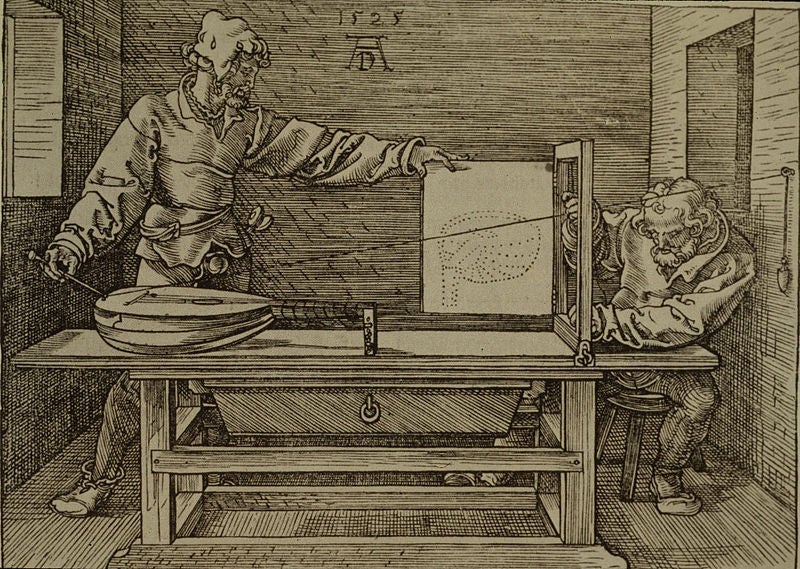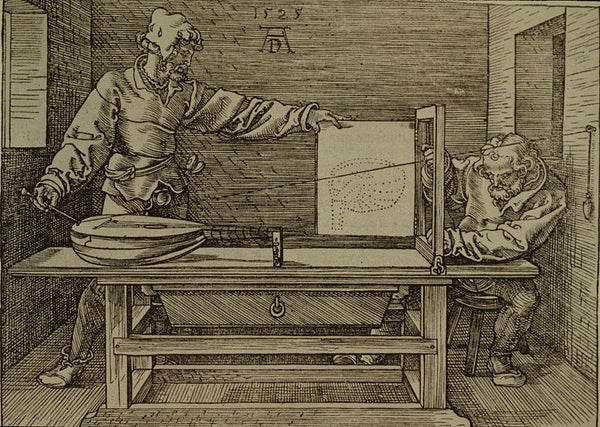This article was published in Scientific American’s former blog network and reflects the views of the author, not necessarily those of Scientific American

Man Drawing a Lute, by Albrecht Dürer. Image: Public domain, via Wikimedia Commons.
Last month, I went to a talk by mathematician Annalisa Crannell of Franklin and Marshall College called Math and Art: the good, the bad, and the pretty. She talked about how mathematical ideas of perspective show up in art and how it can help us create and appreciate art. One of my favorite parts of the talk was on this engraving, from Albrecht Dürer's 1525 text A Painter's Manual. Dürer is best known for his paintings and engravings, but he was a mathematician as well, and the manual is basically a practical geometry text for artists.
The engraving shows two people drawing a lute using a mathematically sound but agonizingly slow method. The canvas they are drawing on is attached to its frame with hinges, and it is swung open in the picture. The person on the left has a small stick that is attached to a string. The string then goes all the way to the wall on the right, where it goes through a small hole and has a weight at the end to keep it taut. The man places the end of the stick somewhere on the lute, and that's where his buddy comes in. The man on the right takes two strings or wires and attaches them to the frame, one from top to bottom and one from left to right, so that they meet at the point where the longer string goes through the frame, much like coordinate axes. They push the long string out of the way, swing the canvas back into the frame, and draw a dot on the canvas where the two strings intersect. And that's just to draw one point! They have to repeat this painstaking process for every point they want to include in their picture.
On supporting science journalism
If you're enjoying this article, consider supporting our award-winning journalism by subscribing. By purchasing a subscription you are helping to ensure the future of impactful stories about the discoveries and ideas shaping our world today.
The method, if employed, would indeed create a perfect perspective drawing of a lute because light travels in straight lines. But as Crannell said, "This is the original dot matrix printer. And for those of you who remember dot matrix printers, it's about the same speed. I cannot imagine that anybody ever actually did this." But I love that this sixteenth century painting manual contained instructions for a purely theoretical painting method. It's such a mathematician thing to do.
Presumably Dürer did not actually use the depicted method to draw the lute in the engraving, so you might be curious about whether it is drawn accurately. In the course of preparing this piece, I found a blog post by artist Gilbert Riedelbauch that investigates exactly that question. And if you're interested in more of Dürer's mathematical drawing techniques, check out this post by Dave Richeson about his instructions for drawing nearly regular polygons.
Dürer dedicated the book to his friend Willibald Pirckheimer, whose sister Euphemia was the abbess of Bergen. She wrote to her brother about the book's reception at the convent: "A book has now reached us which Dürer dedicated to you about painting and measurement. Our gracious Duke Ottheimer had it bound for us and presented it to our paintress. We enjoyed it, but our paintress thinks she does not need it. She can practice her art just as well without it."
